It's not uncommon for me to hear from someone, "We do diversity too." I always reply with, "Well, what was your diverse hiring last year?" or "What are your retention goals for this year?" or "Can you tell me about your pay parity data?" I generally get a blank stare, and the conversation moves on to how diversity is important for their business. But in my mind, and as any engineer will tell you, solving a problem starts with data.
Data and analytics are revolutionizing the largest industries and the smallest businesses, changing everything from how health care is delivered to how we experience sports. With all the amazing advances being driven by data, why is it, then, that the tech industry is still struggling to do what's needed to be done with diversity data?
Diversity data speaks for itself. Or more to the point, the data speaks for those who are not yet fully represented in technology jobs--female, African-American, Hispanic/Latino, and Native American talent. Full representation has significant implications for driving growth in the technology sector. A recent study by Intel and Dalberg Global Development Advisors shows that the correlation between workforce racial/ethnic diversity and financial performance is sizable and clear. For every incremental percentage point in African-American and Hispanic representation at NASDAQ-listed tech companies, there is a 3-percentage-point increase in revenues. That means the technology sector could generate a 20 to 22 percent increase in revenue--an additional $300 to $370 billion each year if our workforces more fully reflected the racial/ethnic diversity available in today's engineering talent pool. So speaking is not enough. It's high time that high tech started doing diversity and inclusion differently.
Evolving diversity to be about both diversity and inclusion will play a central role in the continued proliferation of technology globally. Diversity brings a critical mass of difference into our workforce. Inclusion goes hand in hand with diversity because you can't include who you don't have. Inclusion is an accelerant--revolutionizing how we work, enabling every single one of us to bring our full selves to work with confidence and impact. When our workplaces have diversity and inclusion, real breakthrough happens.
Let's start with diversity data.
Show more of it publicly. When it comes to "doing" diversity and inclusion, we need to measure what matters: hiring rates, exits and turnover, progression and promotion rates, and pay parity. Tech companies need to share this data publicly, because transparency drives action. We're not talking about trade secrets here. We're talking about data to understand problems, and the actions to solve them.
Let's go get the data, make it public, and do something about it. Use data to debunk the pipeline myth that "there are just not enough good candidates" to hire diversity in great numbers. Let the data tell the truth. Last year, Intel set a goal that 40 percent of all new hires had to be women or underrepresented minorities. We managed to exceed this goal, hitting 43.1 percent. We did so by broadening our talent searches, going beyond our go-to recruitment tactics, and trusting in our calculated data of women and underrepresented minorities available in today's talent marketplace. If we are to truly drive a more inclusive global workforce, it's also well past time for us to expand our diversity categories. The tech industry can step up to lead recruiting and welcoming veterans, LGTBQ individuals, and persons with disabilities into our workforce.
Lastly, use the data real-time to retain and develop our employees.
Feelings of isolation, barriers to the next job or next level, and lack of sponsorship are some of the biggest issues facing women and underrepresented minorities in high tech. It's incumbent upon us as leaders to address these issues today. The reality is that "like attracts like," and we unconsciously choose what we know and who we know. We need to get more comfortable with seeking out people who are not like us. We need to build relationships and provide experiences that matter. It's about looking at our corporate cultures and creating environments in which our people spend their energy solving complex and challenging problems, not struggling to fit in. It's about saving a valuable but disheartened employee from leaving by making meaningful changes in their job and environment.
Leading with data, debunking myths and unconscious bias, and focusing on the immediate retention and progress of our people would go a long way toward achieving fuller representation in high tech. We're seeing it beginning to work at Intel, and we invite the industry to do more with us.
The scariest part of being transparent with data is that it sometimes shows you're not winning. But, if we all share the data, we'll find the help we receive far outweighs the anxiety about winning. Sharing diversity data publicly truly enables us to learn from one another's successes and failures.
It's time to do diversity and inclusion differently. Let's break out of our industry's current cycles of underreported and inconsistent data. We simply can't wait any longer. Providing the amazing experiences of technology for tomorrow depends on doing these actions today.

